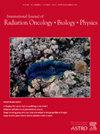Phase II Trial of Proton Re-Irradiation+/-Chemotherapy in Previously Irradiated Recurrent Head/Neck Cancer
IF 6.4
1区 医学
Q1 ONCOLOGY
International Journal of Radiation Oncology Biology Physics
Pub Date : 2024-10-01
DOI:10.1016/j.ijrobp.2024.07.051
引用次数: 0
Abstract
Purpose/Objective(s)
To report the results of a multi-center phase II trial of using proton re-irradiation (re-RT) for previously irradiated recurrent head/neck cancer (HNC).
Materials/Methods
Recurrent HNC patients who received >/= 40 Gy of prior head/neck radiation were enrolled. Patients received fractionated re-RT (F-Re-RT to 70 Gy) or QUAD Shot re-RT (QS-Re-RT, 4 cycles to 59.2 Gy) at physician discretion. The primary endpoints (Clopper-Pearson Confidence Intervals method) were to determine the 12-months, 6-months locoregional recurrence-free (LRRF) rates for F-Re-RT and QS-Re-RT, respectively. Secondary endpoints were to determine: overall survival (OS), progression-free survival (PFS) [both estimated using the Kaplan-Meier method]; distant metastasis (DM), locoregional recurrence (LRR) rates [both calculated from using the Cumulative Incidence Function with death as a competing event]. Patient reported outcomes (PROs) included EORTC QLQ-HN35, PRO-CTCAE, Skindex-16, OMWQ-HM mucositis, EQ-5D. Median follow-up was calculated using the Reverse Kaplan-Meier method.
Results
From July 2017 to November 2022, 88 patients were enrolled (85 analyzable): F-Re-RT (n = 57) versus QS-Re-RT (n = 28). F-Re-RT patients were young with better performance status versus QS-Re-RT patients. Median follow-up was 35 months (all patients); F-Re-RT (38 months); QS-Re-RT (23 months). The 1-year LRRF rate for F-Re-RT was 71% (90% CI = 59%, 81%); 6-month LRRF rate for QS-Re-RT was 76% (90% CI = 58%, 89%) [See table for treatment factors, other endpoints] 36% of the patients had acute grade 3-4 toxicities, most notably dermatitis, dysphagia, dysgeusia. Late grade 3 complications were 20% (see the Table below). Nine patients had grade 4 and 3 had grade 5 complications. The Baseline, 1-year post re-RT mean score of EORTC QLQ-HN35 for F-Re-RT versus QS-Re-RT were 31.05 to 39.09 versus 35.43 to 14.85. Other PROs will be presented at the meeting.
Conclusion
In this largest and first multi-center phase II trial for recurrent HNC patients, proton therapy achieved remarkable locoregional control and survival. Although long-term survivors (> 5 years) were observed which compares very favorably to other treatment modalities, especially when multiple therapies were done prior to re-RT with proton, these patients remain at risk for late complications.
曾接受过放射治疗的复发性头颈癌的质子再放疗+/化疗 II 期试验
目的报告一项多中心II期试验的结果,该试验对既往接受过头颈部复发性癌症(HNC)照射的患者使用质子再照射(re-RT)治疗。材料/方法既往接受过>/= 40 Gy头颈部放射治疗的复发性HNC患者入选。患者由医生决定接受分次再放射治疗(F-Re-RT,70 Gy)或QUAD Shot再放射治疗(QS-Re-RT,4个周期,59.2 Gy)。主要终点(Clopper-Pearson置信区间法)是确定F-Re-RT和QS-Re-RT分别在12个月和6个月无局部复发(LRRF)率。次要终点是确定:总生存期(OS)、无进展生存期(PFS)[均采用卡普兰-梅耶法估算];远处转移率(DM)、局部区域复发率(LRR)[均采用累积发病率函数计算,死亡为竞争事件]。患者报告结果(PROs)包括 EORTC QLQ-HN35、PRO-CTCAE、Skindex-16、OMWQ-HM 粘膜炎、EQ-5D。采用反向卡普兰-梅耶法计算随访中位数。结果2017年7月至2022年11月,88名患者入组(85名可分析):F-Re-RT(n = 57)与QS-Re-RT(n = 28)。与QS-Re-RT患者相比,F-Re-RT患者更年轻,表现状态更好。中位随访时间为 35 个月(所有患者);F-Re-RT(38 个月);QS-Re-RT(23 个月)。F-Re-RT的1年LRRF率为71%(90% CI = 59%,81%);QS-Re-RT的6个月LRRF率为76%(90% CI = 58%,89%)[治疗因素、其他终点见表] 36%的患者出现急性3-4级毒性反应,最明显的是皮炎、吞咽困难和发音障碍。晚期 3 级并发症占 20%(见下表)。9名患者出现4级并发症,3名患者出现5级并发症。F-Re-RT与QS-Re-RT的EORTC QLQ-HN35基线分和再RT后1年的平均分分别为31.05分至39.09分和35.43分至14.85分。结论在这项针对复发性 HNC 患者的最大规模和首个多中心 II 期试验中,质子治疗取得了显著的局部控制和生存率。虽然观察到了长期生存者(5 年),这与其他治疗方式相比非常有利,尤其是在使用质子再放射治疗之前进行了多种治疗的情况下,但这些患者仍然面临晚期并发症的风险。
本文章由计算机程序翻译,如有差异,请以英文原文为准。
求助全文
约1分钟内获得全文
求助全文
来源期刊
CiteScore
11.00
自引率
7.10%
发文量
2538
审稿时长
6.6 weeks
期刊介绍:
International Journal of Radiation Oncology • Biology • Physics (IJROBP), known in the field as the Red Journal, publishes original laboratory and clinical investigations related to radiation oncology, radiation biology, medical physics, and both education and health policy as it relates to the field.
This journal has a particular interest in original contributions of the following types: prospective clinical trials, outcomes research, and large database interrogation. In addition, it seeks reports of high-impact innovations in single or combined modality treatment, tumor sensitization, normal tissue protection (including both precision avoidance and pharmacologic means), brachytherapy, particle irradiation, and cancer imaging. Technical advances related to dosimetry and conformal radiation treatment planning are of interest, as are basic science studies investigating tumor physiology and the molecular biology underlying cancer and normal tissue radiation response.

 求助内容:
求助内容: 应助结果提醒方式:
应助结果提醒方式:


